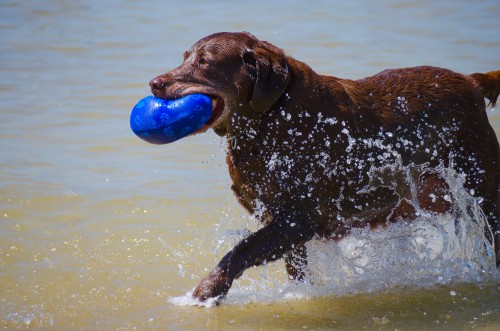 As we age it’s easier to be sedentary versus active. Our muscles hurt, our back may throb and we have a million and one excuses why we can’t exercise. It’s easier to pick up the remote than to put your walking shoes on.
As we age it’s easier to be sedentary versus active. Our muscles hurt, our back may throb and we have a million and one excuses why we can’t exercise. It’s easier to pick up the remote than to put your walking shoes on.
Like people, senior dogs need to exercise. Not at the pace of a puppy, who have a relentless amount of energy but at a slower pace. Prevention is often the key to helping your dog live a long and happy life. He needs to exercise, be seen by a vet regularly, and eat a nutritious well balanced diet. It’s important for dog owners to understand their dog’s limits and create an exercise routine that all parties will enjoy.
The aging process brings with it loss of muscle tone and balance, which can lead to inactivity. Inactivity leads to weight gain and added stress on joints that are no longer well supported by adequate muscle mass. It can become a vicious circle!
Fun outdoor activities
Swimming is a great exercise for both older people and older dogs because it is low impact and less strenuous on weakening joints and muscles. Swimming helps to keep your dog’s muscles strong and can be relaxing and soothing particularly in the summer as a means to cool off.
Whereas your dog used to run and jump, it’s important that if he is still capable to take him on daily walks. The walks may be shorter in distance, but he is still getting some aerobic activity. It’s important not to overdo it. Many dogs still like to play a rousing came of fetch or Frisbee – it is just the duration of the game that should be shortened.
As your dog ages, he may be more sensitive to temperatures, especially when it is extremely hot or cold outside. Take your dog for walks in the morning or early evening, when the temperatures cool down. The opposite is true in the winter depending on where you live — you might have to wait for it to warm up!
Fun Indoor Activities
Dogs love interactive toys, especially those where they have to work for some kibble or a treat. If they’re able to go up and down the stars, have them move around your home and go up and down stairs slowly to keep their joints moving and muscles loose. If climbing stairs is too hard, invest in some ramps to help your dog keep moving around the house without causing them too much pain.
Keeping Senior Dog’s Healthy
It’s important as dog’s age that you keep them at an optimal weight because the extra pounds may make it harder to exercise. Senior dog’s nutritional needs are much different than that of a puppy. Talk to your vet about medicine or supplements that may help your dog with arthritis or other degenerative conditions.
After a tough day of exercise, make sure you have a dog bed that provides plenty of support and is comfortable. Who doesn’t love flopping into bed after a long day? Also, consider giving your dog regular pet massages using slow, gentle strokes and stretches, combined with light, rhythmic tapping. Massages can help keep your senior pet’s muscles toned and reduce the slackening that comes with aging. Regular massage also eases the stiffness of arthritis, which can help your pet maintain his normal gait and active lifestyle.
If your dog’s hips hurt and he finds it difficult to move around, consider getting him a dog harness like the Help ‘Em Up harness. This will help your dog to stay mobile and be able to go places with you. Plus, it will save your back so you can continue to exercise. Lifting a heavy dog in and out of the car or up and downstairs could cause you problems!
It’s important to make sure your dog’s last years are healthy and enjoyable … celebrate his life!
